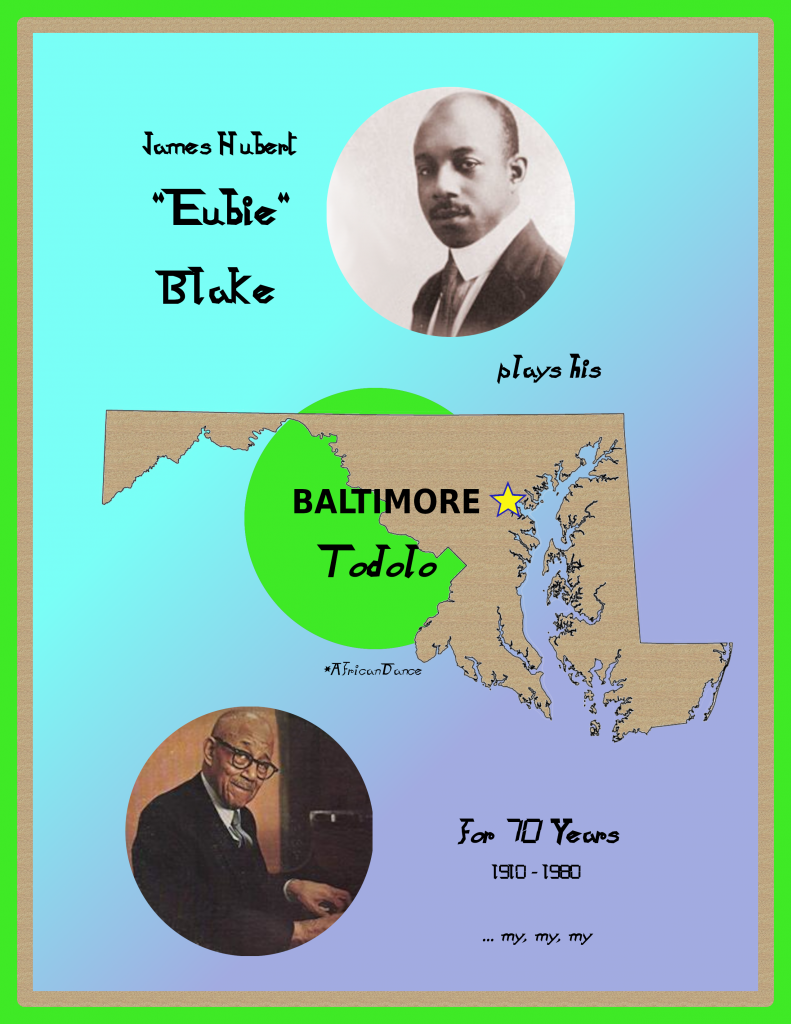Eubie Blake composed the Baltimore Todolo in 1910.
I spent over 40 hours painstakingly transcribing this ragtime classic into LilyPond source code, without having viewed or referenced any other existing transcription. The idea was to generate sheet music that accurately represents the music exactly as played, as opposed to someone’s own approximate version of it. It’s gratifying to be able to play it just like Blake, complete with most of the proper timing and dynamics. It gives insight into the thought process and piano technique that makes his style unique, even clarifying some of the finger and hand motions he must have used.
When transcribing, it’s often difficult deciphering which notes are being played, especially in chords during noisy sections of music. This kind of transcription would not be possible without software like “Transcribe!” which performs a frequency analysis and allows the music to be played at speeds ranging from normal to very slow, without frequency shift – but also allows a frequency shift when it’s useful to better hear lower or higher notes. I often end up repeating a single chord for minutes on end while trying to reproduce the notes on my nearby piano keyboard until the right combination suddenly clicks in an “aha” moment.
In some cases it might appear a composer playing his own composition has made a “mistake.” However, one could reasonably argue that that’s not possible, especially since he never plays it the same way twice. For this reason I reproduce most of the oddities in the recording. Some of them include measure 8 (G+A), 56 (B-flat strike indicates probably played RH only), 67 (final F octave slid onto G), 82 (played even weirder than this), 84 (pounding almost indecipherable), 90 (the 2nd high D is played nearly as C, tied with the following C), 93 (he slides the 4th finger many times in Charleston Rag), 94 (odd RH), 96 (missing D-flat in LH).
Blake is often heard shouting phrases during live performances. Those are included for fun; I think I’ve got them right.
Like much ragtime music, this piece is to be “swung,” meaning that pairs of 8th notes are to be played more like triplet 8th notes, where an 8th rest is added in the middle of each pair. I note this at the beginning of the piece, then present the whole piece using plain 8th notes. I also have LilyPond add swing during MIDI generation. This method of writing swung music using plain 8ths is much preferable to what some transcribers do, which is to use a dotted 8th and a 16th. Besides resulting in a messy score, the rhythm is just wrong. The overly-pronounced swing irretrievably ruins the MIDI output. In this piece, the magnitude of the swing varies from considerable to barely detectable. I’ve tried to notate that using an asterisk for straight 8ths. There isn’t any standardized notation for that, other than by writing out the words straight eighths, which is overkill when just a few notes need to be straight, and frequently so.
The source recording I used was released by Columbia Records in 1969 and was made available on YouTube. I could only find this one version, unlike the Charleston Rag, which has a piano roll and at least three recorded performances by Blake himself. In the case of the Charleston Rag, my transcription is mostly accurate to a recording in 1972, but I also incorporated some details from an early piano roll that found more enjoyable to play.
Here is a cover page I designed using GIMP (the open source GNU image editor similar to Photoshop).

And here is a PDF of my transcription (4 pages):
Here is a MIDI file for download, and also an on-line MIDI player for instant gratification. This barebones MIDI player doesn’t do it justice, so I’d recommend downloading the MIDI and playing through a better program. LilyPond’s MIDI output is pretty good when using the “articulate” module. I also use a module that generates the swing (swing.scm), which I’ve further customized to exclude the small sections that are to be rendered as straight eighths.